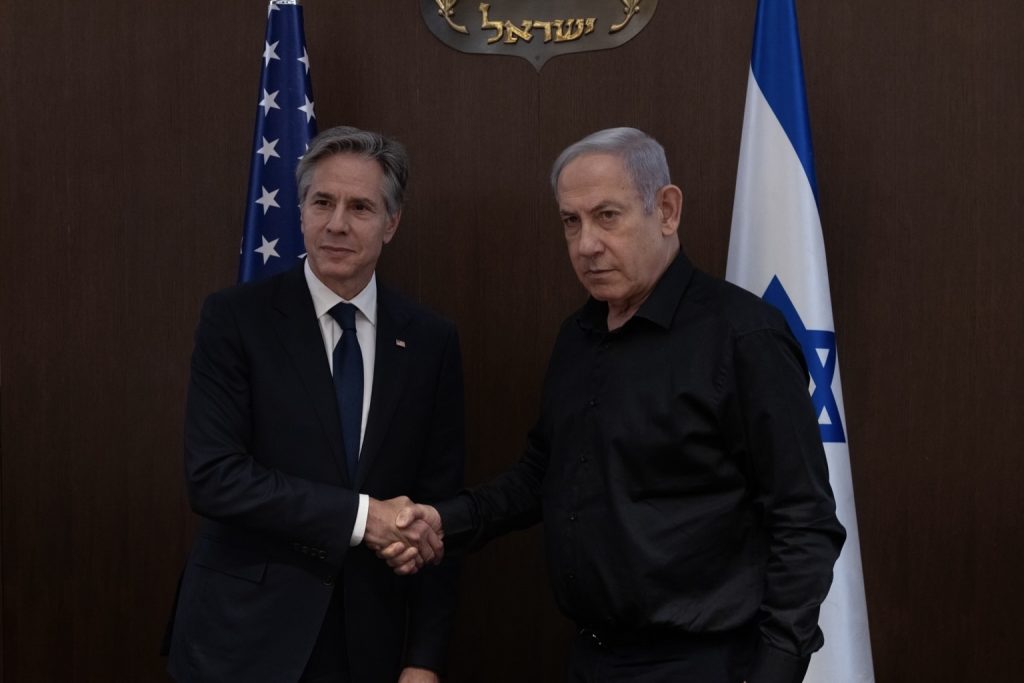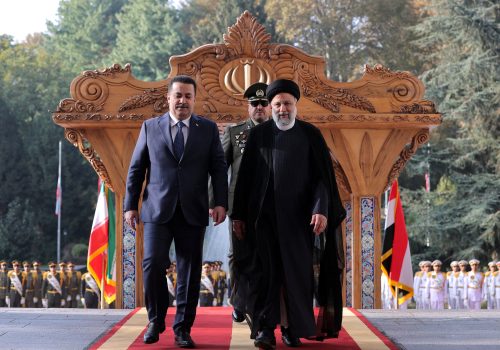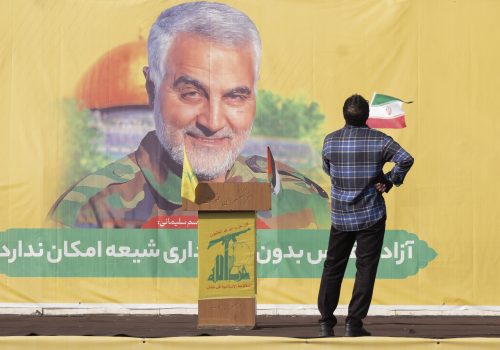What lasting effect have Hamas’s October 7 attacks and Israel’s ongoing response in Gaza had on US strategy in the Middle East? The answer to this question is emerging, and recent days provided two windows into the Biden administration’s approach to the conflict and to Middle East and global security challenges more broadly. Hamas’s expected release of some of its hostages in exchange for a pause in fighting is but the first step of the administration’s path to resolve the Gaza conflict and address broader sources of instability in the region. The principles guiding the approach are, in fact, unchanged from before October 7. And while the conflict has increased the urgency for the United States to engage in the region, it is just one of several developments that require renewed US leadership.
The most recent window into the administration’s thinking was White House Coordinator for the Middle East Brett McGurk’s address at the Manama Dialogue 2023 in Bahrain on Saturday. The second window was President Joe Biden’s Washington Post editorial, “The US won’t back down from the challenge of Putin and Hamas.” Notably, McGurk’s Manama remarks came as part of the administration’s efforts to secure a temporary ceasefire in Gaza and release a portion of the Hamas-held hostages, in a deal announced Tuesday that will also involve Israel releasing dozens of Palestinian prisoners. (Qatar was the lead mediator in the deal.)
The clarity in what Biden and McGurk presented in recent days came from the consistency of language, which traces a path from Biden’s 2022 meetings in Saudi Arabia with the leadership of the Gulf Cooperation Council. They follow the five guiding principles that McGurk presented as a “Biden doctrine” for the Middle East at the Atlantic Council in February: partnerships, deterrence, diplomacy, integration, and values. In my previous role on the National Security Council working under McGurk, I saw these principles develop firsthand, as they manifested in Biden’s 2022 trip to the region and in the 2022 National Security Strategy’s approach to the Middle East.
Even after the October 7 attacks, these five principles underpin the steps the United States is taking today, including the affirmation of the United States’ ironclad support for Israel’s security. However, both Biden and McGurk emphasized a path for Israel’s security that is strategic in nature and goes beyond a hard-power based guarantee. Indeed, they make clear that Israel’s long-term security is dependent on allowing the Palestinian people to live securely in a state of their own. The United States is unique in its ability to both guarantee Israel’s security and force progress toward a viable two-state solution. Biden’s editorial, McGurk’s Manama remarks, and US Secretary of State Antony Blinken’s related remarks at a Group of Seven (G7) meeting on November 8 contain the same elements that lay out this path.
These elements include five preventative steps for Gaza: 1) no forceable displacement of Palestinians within Gaza, 2) no Israeli reoccupation of Gaza, 3) no reduction of Gaza’s territory, 4) no use of Gaza to attack Israel again, and 5) no besiegement of the civilian population.
The five affirmative steps to achieve a durable solution to the crisis look to a future, improved order: 1) The Palestinian people must be at the center of a post-crisis Gaza; 2) the West Bank and Gaza must return to unified governance; 3) Israel must be secure; 4) Gazans need quality of life improvements; and 5) Gaza needs a viable reconstruction mechanism.
The interrelated factors driving US strategy
There is a danger in this tense moment to view the conflict in isolation. The most immediate need is to solve the Israel-Hamas conflict, reestablish Israeli deterrence, and progress toward a two-state solution. But this must be done together with a broader set of US actions, including:
- Communicating the United States’ commitment to the region following the 2021 US withdrawal from Afghanistan and subsequent US defense posture reductions
- Countering Chinese expansion
- Countering Russia’s full-scale invasion of Ukraine, which has implications for the Middle East
- Countering Iranian regional aggression
- Fostering alignment between Israel and Saudi Arabia
The United States must take these actions because it is the singular entity that exerts a preponderance of influence over all the interrelated factors in play.
The Israel-Hamas conflict. Hamas’s October 7 attack ruined Israel’s deterrent credibility. This would have been the case even if Israel had been able to eliminate Hamas over the past few weeks. Israel’s image as a counterbalancing force against Iran is temporarily diminished. Consequently, the United States deployed two carrier strike groups and other significant military capabilities to the region with the intention of deterring Iran and its proxies from expanding the conflict. The United States has also conducted three separate self-defense strikes against Iranian proxies in Syria over the past few weeks. While Israel’s campaign in Gaza is meant to eliminate Hamas and reestablish deterrence, significant numbers of civilian casualties will make a post-conflict political settlement with the Palestinian population in Gaza and the West Bank more difficult. This settlement, and regional Arab acceptance of it, will have greater influence over Israel’s security than its near-term efforts against Hamas.
Afghanistan and the 2021 global posture rebalance. Just as the United States was withdrawing from Afghanistan, it was also shifting significant amounts of its most capable combat capability from the Middle East to Europe and Asia. Despite words of assurance from senior Biden administration officials at the time, leaders in the region saw these moves as a sign that the United States was no longer committed to the defense of the region. Coupled with congressional holds on arms sales to Saudi Arabia and the United Arab Emirates (UAE), several regional states chose to diversify their security relationships with countries such as China. The administration’s recent moves to establish new security agreements in the region, as well as unlock arms sales, are a means to keep key regional states connected to a US-led regional order that is dependent on first resolving the Gaza conflict.
Countering Chinese expansion. As several Middle Eastern states expanded their military and technology relationships with the People’s Republic of China, this diversification created a vicious cycle whereby the presence of Chinese technology and infrastructure made it more difficult to offer US alternatives. For the past two years, the Biden administration has worked to get regional states to divest themselves of certain Chinese tech systems while offering US alternatives. Further, to counter Chinese economic infrastructure investments, the United States announced the launch of the India-Middle East-Europe economic corridor during the 2023 Group of Twenty (G20) Summit. Despite its potential economic benefits, the corridor will be dependent on an integrated Middle East—which will also require the positive resolution of the Gaza conflict.
Supporting Ukraine against Russia. Diplomatically, the Middle East region has voted in support of Ukraine at the United Nations. However, the region has not publicly provided military support to help Ukraine resist Russia’s full-scale invasion. The region has either sought to insulate itself from the international consequences of the invasion, such as food scarcity and inflation in Egypt and Jordan, or benefit from rising energy prices, as in the case of Saudi Arabia, the UAE, and Qatar. Significantly, Israel has remained on the sidelines of the Ukraine conflict due to Israel’s need for Russian acquiescence to Israeli strikes against Iran-related targets in Syria. Although the Biden administration has worked to counter Russian attempts to use the region to bypass sanctions, US leadership in the region remains important to preventing Russia from gaining access to sanctions loopholes. As Biden articulated, US support to Ukraine carries reputational importance to the region by communicating the United States’ commitment to pushing back against aggression and maintaining world order.
Countering Iran. Due to the Trump administration’s “maximum pressure” campaign against Iran, its 2020 strike against Iranian Revolutionary Guards Corps Quds Force Commander Qasem Soleimani, and Iran’s demonstrated willingness to conduct state-on-state attacks against Saudi Arabia and the UAE, the Biden administration began with a depressurization approach to the region. This was intended to reduce the potential for conflict in the region and resulted in a tenuous but enduring ceasefire in Yemen. Further, although the United States conducted several calibrated strikes in Syria, the strikes did not lead to escalation. However, the reduction in US military posture and stalled US arms sales to partners in the region has meant that although the region had been depressurized, deterrence against Iran was based on variables, such as Israel’s deterrent credibility, that were subject to change.
Fostering Saudi-Israeli alignment. In the first half of the Biden administration, the United States pursued diplomacy to both depressurize the region and to align Saudi Arabia with Israel. This explains why Biden’s first trip to the region was to Israel and Saudi Arabia in 2022. It also explains why the administration was pursuing both Saudi-Israeli normalization as well as security agreements that would signal the United States’ commitment to the region’s security. The diplomatic dividends of this effort were expected to fully unlock US arms sales to Saudi Arabia, as well as enable practical aspects of the India-Middle East-Europe economic corridor. This effort is on hold due to the Israel-Hamas conflict, but the recent visit of Saudi Minister of Defense Prince Khalid bin Salman to the White House and the Pentagon indicated the Saudis’ willingness to restart this process at some point in the future.
Thus far, the United States has successfully mitigated the immediate military risks associated with Hamas’s October attack, and a significant regional expansion of the conflict. Although the Israel-Hamas conflict is far from over, the announced temporary ceasefire and partial release of hostages open avenues for humanitarian assistance and expanded diplomacy. These recent efforts can serve to reduce the tension between Israel’s goal of eliminating Hamas and consequent civilian casualties and worsening humanitarian conditions. By helping deliver this progress, it is clear the White House understands that Israel’s longer-term security requirements remain attached to Biden’s statements regarding the need to safeguard civilian lives and for Israel to not act like an occupying force in Gaza.
Long-term security in the Middle East will start with the ability to maintain an enduring regional deterrent order against Iran and its proxies. Since the 2021 Global Posture Review demonstrated that the United States lacks the forces to maintain a significant, permanent defense posture in the Middle East, this regional order will depend on the United States pressing toward a two-state solution. This progress will in turn allow for Israel to normalize its relationship with Saudi Arabia and more comprehensively integrate itself into the region. On top of the benefits of expanded normalization, US security agreements, which regional states are seeking, will signal the United States’ commitment to the defense of the region. As both Biden and McGurk articulate, the future success of these efforts are, in many ways, dependent on how the United States can shape Israeli actions. A laudable first step along this path is the temporary ceasefire and partial release of hostages.
Daniel E. Mouton is a nonresident senior fellow at the Scowcroft Middle East Security Initiative of the Atlantic Council’s Middle East Programs. Mouton served on the National Security Council from 2021 to 2023 as the director for defense and political-military policy for the Middle East and North Africa for Coordinator Brett McGurk.
Further reading
Tue, Oct 24, 2023
The global consequences of the Israel-Hamas war are just beginning. Here’s what to watch.
The Big Story By Kirsten Fontenrose
It's hard to predict what decisions the players will make tomorrow, but here are the early warning signs that could indicate what will come next in the Middle East and beyond.
Fri, Nov 17, 2023
The Gaza war is a reminder that the US needs to reevaluate its Iran policy
IranSource By
Despite the Biden administration's efforts to prevent a further escalation and the expansion of the Israel-Hamas war in the region, Iran-backed militia groups continue to challenge US forces.
Wed, Nov 8, 2023
The Gaza war raises questions about the future of Iran’s Resistance Axis
IranSource By
The Gaza war presents the first significant test of the level of cooperation present among the elements of the Iran-led Resistance Axis.
Image: United States Secretary of State Antony Blinken meets Israel Prime Minister Benjamin Netanyahu in Tel Aviv, Israel, on Tuesday Oct 17, 2023. President Joe Biden will make an extraordinary wartime visit to Israel this week as he seeks to demonstrate staunch support for the country as it works to eliminate Hamas while also pressing for ways to ease humanitarian suffering in Gaza.



